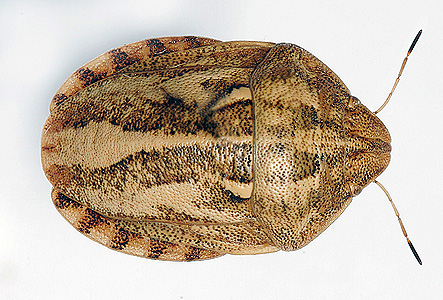
The bug insect bug (Eurygaster integriceps) is a dangerous pest of grain crops, showing maximum activity during their growth and maturation. Often you can find this insect on young shoots of wheat or on the ears in the stage of wax maturity.
Although this bug is mainly the enemy of large industrialists, it often damages decorative cereals, which is why it is useful to know the nuances of dealing with it to everyone who is somehow connected with agriculture.
What a bug bug looks like
The bug, an oval with a flat calf, a bug, which photo is presented below, is quite recognizable:
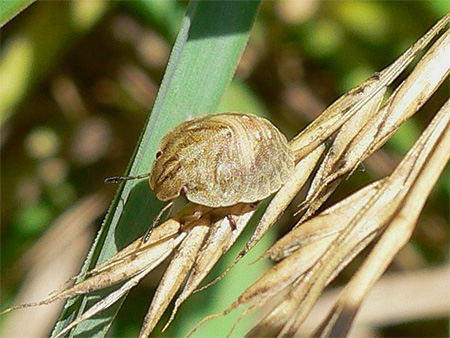
Although the insect can have several variants of coloring: gray, brown-gray, yellowish-gray, it differs from other pests by a very dense protective shield-shell, which is covered with patterns - dots or lines.Most often these patterns are whitish, but sometimes they can have a light green or silver shade.
The pronotum of the bug is approximately twice the size of the head, the wings are rounded. This bug flies perfectly and in search of food can cover distances up to 200 km!
The oral apparatus is piercing-sucking, with its help the pest bites through the stalks of wheat, sucking the juice from the capillaries of the plant.
The pictures of the bug eggs are small, round and greenish in color:

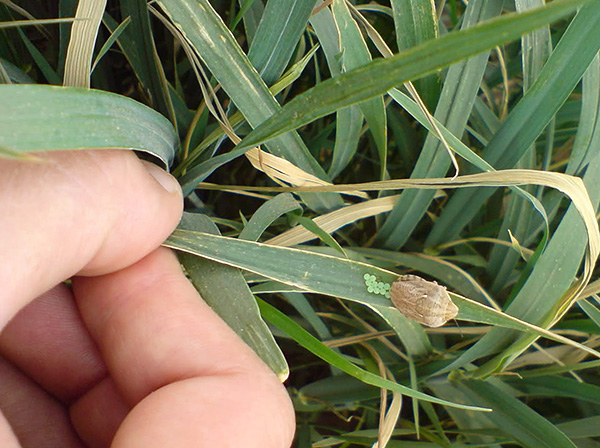
7-10 days after laying eggs, larvae appear, which go through 5 stages of development and gradually approach the appearance of an adult individual. The photo shows the bug bug bug in the stage of the 1st instar larvae:
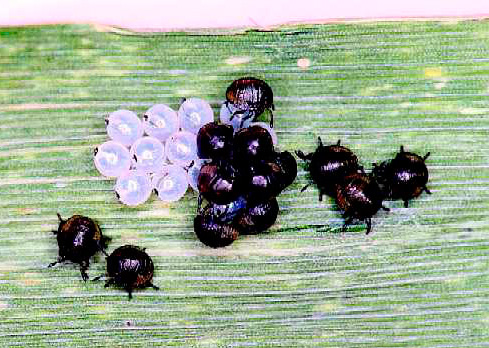
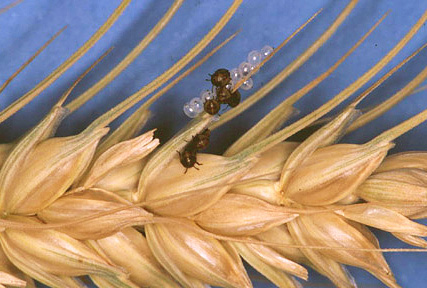
Feedback
“Never before encountered such a pest. But recently they planted a new section of the field, right near the meadow. It can be seen, from there, these turtles and flew. Pretty big bugs, colorful, fly well. After them, wheat is absolutely not suitable for grinding, the dough is sticky ... now we are actively trying to bring them out, but so far nothing helps. The bug on wheat is a real attack for the harvest. ”
Nikita Antonovich, Krasnograd
Pest lifestyle
Bug turtle is a great threat to crops - they are his source of food. In winter, the bugs are looking for a new temporary place of residence, moving under the leaf litter in the forest or stopping on perennial weeds. Sometimes barns or wheat bins can serve as a wintering place.
With the onset of spring heat (10-15 degrees), bugs fly in search of early winter crops. As soon as they find a place suitable for feeding and living, the mating of the males and the females occurs massively. 10-15 days after that, each female of the harmful turtle lays 30-40 eggs, mainly on the leaves of the plant.
After 7-10 days, new larvae appear, which feed in the same way as adult insects. Due to a sharp increase in the number of bugs during their reproduction, they can destroy a serious part and even completely the entire crop in a certain area.
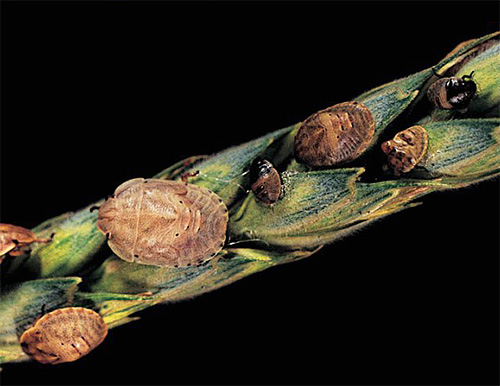
The full cycle of transformation of the larva into imago takes 20-30 days, during which the insect goes through five stages of maturation and molting, each time becoming more and more like an adult bug.If the larvae are most often found on the plant where they were born, then after turning into an imago, new bugs of the turtle begin to actively populate the neighboring spikes and multiply, gradually covering huge areas.
The photo shows bug on the spike:
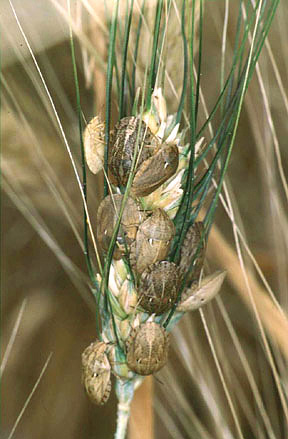
How do bugs and turtles hurt people?
Directly to humans, the bug a harmful bug is harmless. He does not bite, so even if the insect was in the house, the easiest way to throw it out the window.
Before you get rid of the bugs of turtles, you must first detect them. Listed below are signs indicating the spoilage of grain by the bug of a bug;
- the mass withering of young shoots that occurs in a certain zone (if the bugs have not yet inhabited the entire field);
- belkolosost or deformation of the ear, changing its original shape;
- on the ripened ear, there are noticeable chipping of the grain, a change in its color, or traces (points) from the bug bite.
On a note
Scientists have found that the bugs are harmful turtle prefers to eat the most valuable for the human varieties of crops, powerful and able to grow quickly and produce a large number of juices.The pest is really capable of causing very significant damage.
The amount of gluten will be significantly reduced in the grain on which the bug bugs parasitized. The fact is that the bug’s saliva contains a special enzyme that significantly changes the chemical composition of the product and makes it unsuitable for use. Piercing the stem of the plant with its long proboscis, the bug introduces an enzymatic fluid into the capillary, which then spreads along the upper part of the stem and the spike.
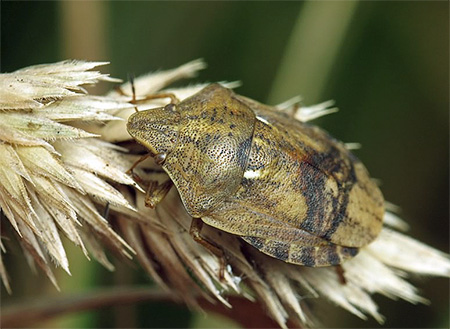
The most interesting thing is that flour ground from grains of damaged ears looks the same as that made from a healthy ear. Here are the properties, it differs far from the best.
After kneading the dough, the enzymes start working again. The dough becomes viscous and viscous, becomes dark gray. Naturally, such flour cannot be used for cooking or baking.
Measures to deal with bedbugs
In order to prevent contamination of grain by harmful bugs, you need to follow some rules:
- Timely harvesting of mature crops, method of direct combining;
- Timely fight against wild weeds, but at the same time compulsory preservation of forest belts and areas of wild vegetation near the field in which natural enemies of bedbugs breed;
- Fertilizer fields. Especially effective will be the use of potassium and phosphorus;
- The use of varieties with increased resistance against parasites.
However, if the bug bug has already penetrated the field and began to multiply there, you need to take drastic measures. In this case, help chemicals adapted specifically for such pests.
It is best to carry out the treatment at the time when the ear has only reached the milky ripeness. At this time, the parasites are just beginning to colonize it, and the resistance will be most effective. You can, for example, use the following drugs:
- Aktara. Neonicotinoid insecticide group, effective in spraying. An hour after application, the insects stop feeding and die completely within 24 hours. Aktara is especially effective at a large accumulation of insects, allows you to quickly and easily destroy the main part of the population;
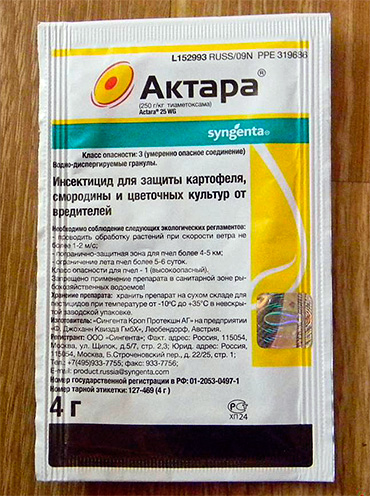
- Karate Zeon.Pyrethroid insecticide that affects the nervous system of insects and causing their early death (from several hours to days). The drug is available in suspension, prevents the emergence of resistance in pests.
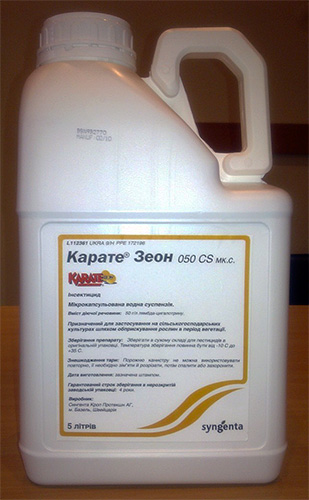
And some others.
Spraying with a solution of drugs can be carried out from the air, or be directed locally directly to the plants. Both of the above insecticides have a fairly wide spectrum of activity, and in addition to the harmful bug, they also destroy other pests of grain crops.
Feedback
In our farm, a harmful bug is usually poisoned with Aktar. The tool is good, bugs only have time to fly, as we spray the composition and after a couple of days they are no longer there. When the larvae hatch, spray again. After that, no problems, not only with the bug, but also with other parasites. This is one of the best insecticides, for a long time only we use it.
Alexander Semenovich, Pavlograd
Bug harmful turtle annually causes huge losses to agriculture, being one of the main pests of grain crops. That is why preventive measures to combat it should always be taken,and at the beginning of infection - to act quickly and massively.
An example of how a bugs harmful turtle spoils the wheat


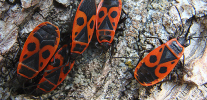

And I have a complete apartment of bugs - harmful turtles. They are so smelly, save no! HOW to fight them, I'll never know! The apartment was treated by experts last summer, the bugs come and die, their dead bodies are lying around on the floor, and the living still bring terror to us.
Mosquito nets to help you)